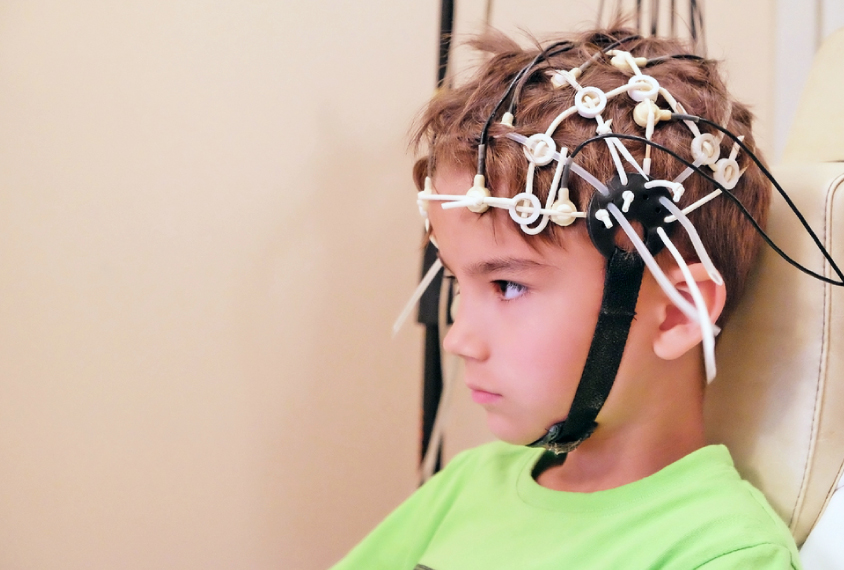
Top autism gene may alter sensory perception
An unusual brain response to sound may distinguish children with mutations in SCN2A, a leading candidate gene for autism.
Editor’s Note
This article was originally published 13 May 2017, based on preliminary data presented at the 2017 International Meeting for Autism Research in San Francisco, California. We have updated the article following publication of a portion of the work 16 March 2018 in Brain Cognition1. Updates appear below in brackets.
An unusual brain response to sound may distinguish children with mutations in SCN2A, a leading candidate gene for autism. Researchers presented the work today at the 2017 International Meeting for Autism Research in San Francisco, California.
SCN2A codes for a channel that allows sodium ions to traverse neurons. In the past two years, it has emerged as one of the genes mostly strongly linked to autism.
The researchers characterized the effects of SCN2A mutations in 10 children. Most of the children were too severely impaired for cognitive tests, so the researchers turned to electroencephalography (EEG), a brain imaging technique that can pick up on responses to sound.
“It’s hard to have valid clinical measures in this group,” says Caitlin Hudac, a postdoctoral associate in Raphael Bernier’s lab at the University of Washington in Seattle, who presented the findings. “We’re trying to bridge the gap by looking at electrophysiology.”
The researchers outfitted the children with a flexible cap covered in tiny electrodes and played a series of tones. About 80 percent of the tones were the same; the rest varied in pitch or length. The children watched a movie, and some even fell asleep, says Hudac. Still, their brains automatically detected the tones.
The researchers plotted the EEG readings across the group to look for boosts in activity in response to the altered tones. They focused on seven children with a type of SCN2A mutation linked to autism, and compared them with their unaffected parents.
Like their parents, the children noted a change in pitch, but their response came early, suggesting they are hypersensitive to sounds.
Timed response:
The researchers also looked at the same measure in 102 children [and young adults] who have autism from unknown causes, and in 31 controls. This group with autism gives a stronger signal in response to the odd tones than controls do, also suggesting hypersensitivity1.
The researchers then looked at how responses to the tones varied over the course of the 14-minute experiment. Typical children need to hear a few unusual tones before they notice and respond differently to them. They eventually get used to these outliers and stop reacting.
The children with autism but with no SCN2A mutation, by contrast, notice the odd tones right away — a feature that may contribute to their hypersensitivity. [They also take longer than controls to get used to the unusual sounds. Children with autism who often seek out noises in their environment, according to their parents, tend to take the longest to stop reacting to the outliers.]
Children with SCN2A mutations need a few tones to notice the odd ones, as typical children do.
The findings suggest that children with SCN2A mutations and those with other forms of autism are both hypersensitive to changes in tone. But the mechanism underlying the response differs.
“Children with SCN2A mutation may have a unique profile related to how they process and discriminate [sensory] information in the world and how they put all this information together,” Hudac says.
Mutation effects:
The researchers are also learning more about the nature of the mutations in SCN2A.
A study published in February showed that mutations that impair the activity of the ion channel lead to autism, whereas those that enhance its activity lead to infantile epilepsy2.
Hudac and colleagues found that of the 10 children they characterized, 7 have mutations that seem to impair the channel’s activity. Six of these seven children have autism, and the remaining girl has features of the condition. All seven children have intellectual disability, and three of them were too impaired to complete a test of intelligence; four of them had had seizures, but not in infancy.
The remaining three children appear to have mutations that increase the function of the channel. Two of them had seizures early in life and do not have autism. The third child is an outlier: She has autism and did not have early seizures.
The researchers will need to confirm that the girl’s mutation enhances the channel’s activity, says Stephan Sanders, assistant professor of psychiatry at the University of California, San Francisco. Sanders was not involved in the new work but led the February study.
It is most likely that the girl’s mutation in fact impairs the channel’s activity, he says. He is collaborating with Hudac and her colleagues to characterize the function of the mutations in the 10 children.
For more reports from the 2017 International Meeting for Autism Research, please click here.
References:
Recommended reading

Expediting clinical trials for profound autism: Q&A with Matthew State

Too much or too little brain synchrony may underlie autism subtypes
Explore more from The Transmitter

This paper changed my life: Shane Liddelow on two papers that upended astrocyte research
Dean Buonomano explores the concept of time in neuroscience and physics

